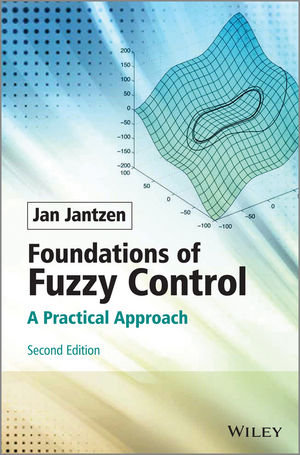
Foundations of Fuzzy Control
John Wiley & Sons Inc (Verlag)
978-1-118-50622-6 (ISBN)
This new edition covers the basics of fuzzy control and builds a solid foundation for the design of fuzzy controllers, by creating links to established linear and nonlinear control theory. Advanced topics are also introduced and in particular, common sense geometry is emphasised.
Key features
Sets out practical worked through problems, examples and case studies to illustrate each type of control system
Accompanied by a website hosting downloadable MATLAB programs
Accompanied by an online course on Fuzzy Control which is taught by the author. Students can access further material and enrol at the companion website
Foundations of Fuzzy Control: A Practical Approach, 2nd Edition is an invaluable resource for researchers, practitioners, and students in engineering. It is especially relevant for engineers working with automatic control of mechanical, electrical, or chemical systems.
Jan Jantzen, Adjunct Professor, University of the Aegean, Greece As a follow-up on the pioneering work by Holmblad and Østergaard on cement kiln control, Dr Jantzen taught a course on fuzzy control at the Technical University of Denmark (starting 1986). He has participated in the development of a fuzzy controller for a 600 kilowatt screw chiller and a fuzzy idle speed controller for a car engine. At the university he supervised numerous student projects in the process industry, and he teaches a fuzzy control course over the Internet to students and practitioners (www.inference.dk). He also teaches a course on fuzzy logic and intelligent computers at the University of the Aegean, Chios island, Greece (since 2003). Dr Jantzen lives on the island of Samso, Denmark, and he works at the Samso Energy Academy with renewable energy, particularly for European islands.
Foreword xiii Preface to the Second Edition xv
Preface to the First Edition xvii
1Introduction 1
1.1 What Is Fuzzy Control? 1
1.2 Why Fuzzy Control? 2
1.3 Controller Design 3
1.4 Introductory Example: Stopping a Car 3
1.5 Nonlinear Control Systems 9
1.6 Summary 11
1.7 The Autopilot Simulator* 12
1.8 Notes and References* 13
2 Fuzzy Reasoning 17
2.1 Fuzzy Sets 17
2.2 Fuzzy Set Operations 25
2.3 Fuzzy If–Then Rules 33
2.4 Fuzzy Logic 36
2.5 Summary 43
2.6 Theoretical Fuzzy Logic* 43
2.7 Notes and References* 53
3 Fuzzy Control 55
3.1 The Rule Based Controller 56
3.2 The Sugeno Controller 61
3.3 Autopilot Example: Four Rules 64
3.4 Table Based Controller 65
3.5 Linear Fuzzy Controller 68
3.6 Summary 70
3.7 Other Controller Components* 70
3.8 Other Rule Based Controllers* 77
3.9 Analytical Simplification of the Inference* 80
3.10 Notes and References* 84
4 Linear Fuzzy PID Control 85
4.1 Fuzzy P Controller 87
4.2 Fuzzy PD Controller 89
4.3 Fuzzy PD+I Controller 90
4.4 Fuzzy Incremental Controller 92
4.5 Tuning 94
4.6 Simulation Example: Third-Order Process 99
4.7 Autopilot Example: Stable Equilibrium 101
4.8 Summary 103
4.9 Derivative Spikes and Integrator Windup* 104
4.10 PID Loop Shaping* 106
4.11 Notes and References* 109
5 Nonlinear Fuzzy PID Control 111
5.1 Nonlinear Components 111
5.2 Phase Plot 113
5.3 Four Standard Control Surfaces 115
5.4 Fine-Tuning 118
5.5 Example: Unstable Frictionless Vehicle 121
5.6 Example: Nonlinear Valve Compensator 124
5.7 Example: Motor Actuator with Limits 127
5.8 Autopilot Example: Regulating a Mass Load 127
5.9 Summary 130
5.10 Phase Plane Analysis* 130
5.11 Geometric Interpretation of the PD Controller* 134
5.12 Notes and References* 143
6 The Self-Organizing Controller 145
6.1 Model Reference Adaptive Systems 145
6.2 The Original SOC 147
6.3 A Modified SOC 150
6.4 Example with a Long Deadtime 151
6.5 Tuning and Time Lock 155
6.6 Summary 157
6.7 Example: Adaptive Control of a First-Order Process* 157
6.8 Analytical Derivation of the SOC Adaptation Law* 161
6.9 Notes and References* 169
7 Performance and Relative Stability 171
7.1 Reference Model 172
7.2 Performance Measures 177
7.3 PID Tuning from Performance Specifications 180
7.4 Gain Margin and Delay Margin 185
7.5 Test of Four Difficult Processes 186
7.6 The Nyquist Criterion for Stability 188
7.7 Relative Stability of the Standard Control Surfaces 191
7.8 Summary 193
7.9 Describing Functions* 193
7.10 Frequency Responses of the FPD and FPD+I Controllers* 198
7.11 Analytical Derivation of Describing Functions for the Standard Surfaces* 206
7.12 Notes and References* 216
8 Fuzzy Gain Scheduling Control 217
8.1 Point Designs and Interpolation 218
8.2 Fuzzy Gain Scheduling 219
8.3 Fuzzy Compensator Design 221
8.4 Autopilot Example: Stopping on a Hilltop 226
8.5 Summary 228
8.6 Case Study: the FLS Controller* 229
8.7 Notes and References* 235
9 Fuzzy Models 237
9.1 Basis Function Architecture 238
9.2 Handmade Models 240
9.3 Machine-Made Models 249
9.4 Cluster Analysis 253
9.5 Training and Testing 263
9.6 Summary 266
9.7 Neuro-Fuzzy Models* 267
9.8 Notes and References* 275
10 Demonstration Examples 277
10.1 Hot Water Heater 277
10.2 Temperature Control of a Tank Reactor 282
10.3 Idle Speed Control of a Car Engine 287
10.4 Balancing a Ball on a Cart 292
10.5 Dynamic Model of a First-Order Process with a Nonlinearity 301
10.6 Summary 307
10.7 Further State-Space Analysis of the Cart-Ball System* 307
10.8 Notes and References* 314
References 315
Index 319
| Verlagsort | New York |
|---|---|
| Sprache | englisch |
| Maße | 177 x 252 mm |
| Gewicht | 699 g |
| Themenwelt | Mathematik / Informatik ► Informatik |
| Technik ► Elektrotechnik / Energietechnik | |
| ISBN-10 | 1-118-50622-7 / 1118506227 |
| ISBN-13 | 978-1-118-50622-6 / 9781118506226 |
| Zustand | Neuware |
| Informationen gemäß Produktsicherheitsverordnung (GPSR) | |
| Haben Sie eine Frage zum Produkt? |
aus dem Bereich


